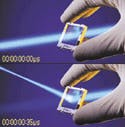A form of phase volume (or Bragg) hologram, the switchable diffractive element replaces the usual holographic medium with a mixture of dye-sensitized polymer and liquid crystal, which solidifies when exposed to light. The resulting layer contains regions populated with liquid crystal to varying degrees depending on exposure intensity. In an electric field, the liquid crystal droplets reversibly change orientation, reducing the refractive-index modulation and switching off the hologram. When switched on, the hologram has a diffraction efficiency of 70%-80%, with close to 100% expected on further development; when switched off, efficiency falls to less than 0.5%. The material can be used at wavelengths between 400 and 1600 nm, support grating pitches of 150 nm, and be cycled indefinitely. The elements can be fabricated using standard holographic contact replication techniques. Uses include switchable lenses, prisms, optical filters, and mirrors.
DigiLens has been pursuing the technology for years in secret, according to Jonathan Waldren, the company's founder and chief executive officer. The switchable liquid crystal material was originally developed for laser defense systems to be used by the US Air Force. Along with the material itself, DigiLens has developed associated software to interface with popular optical-design programs such as Code V (Optical Research Associates; Pasadena, CA), as well as to model the optical exposure process used to create the holograms—a model that is critical to successful fabrication, says Waldren.
Early applications of the switchable holograms include rear-projection monitors in which monitor depth is reduced, resolution is multiplied by sequential projection of images on different portions of the screen (or "tiling"), and color is achieved by sequential switching of red, green, and blue filters. DigiLens has also developed a small wearable near-eye virtual display in which color filters are switched in sequence with red, green, and blue illumination sources. Resolution is increased due to the use of monochrome projection, as well as tiling. "With near-eye displays, we are stitching [aligning adjacent images] with subpixel resolution," notes Waldren.

John Wallace | Senior Technical Editor (1998-2022)
John Wallace was with Laser Focus World for nearly 25 years, retiring in late June 2022. He obtained a bachelor's degree in mechanical engineering and physics at Rutgers University and a master's in optical engineering at the University of Rochester. Before becoming an editor, John worked as an engineer at RCA, Exxon, Eastman Kodak, and GCA Corporation.

